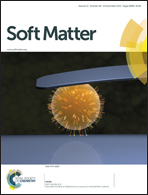Heterogeneous vesicles: an analytical approach to equilibrium shapes
Abstract
We develop an analytical model to predict equilibrium shapes of two-component heterogeneous vesicles or capsules. Using a free energy functional including the bending energies of the two components and line tension contributions, the model describes shape transitions between spherical and polyhedral (faceted) states, complementing and extending results of previous numerical simulations. In the parameter space of relative area fraction, bending modulus ratio, and line tension, a region of polyhedral shapes occurs for weak line tension and large bending modulus ratio and is very robust towards changes in the modeling assumptions. At large enough line tension, the spherical shape fragments into two components. Within the polyhedral region, we compare the energies of all regular and semiregular polyhedra, as well as those of arbitrary prismatic shapes. We find that the largest bending modulus contrasts together with larger line tension favor polyhedra with small face number as optimal shapes. In this region, we also demonstrate the counter-intuitive result that the most symmetric polyhedra are not energetically optimal, with specific Archimedean solids and specific prismatic shapes beating more isotropic (e.g. Platonic) polyhedra. Furthermore, all polyhedra of lowest energy are found to be three-fold coordinated. The shape transition boundary for polyhedra can be computed analytically. The model can be utilized to predict heterogeneous vesicle shapes and to estimate physical properties of the components constituting observed vesicles.


 Please wait while we load your content...
Please wait while we load your content...